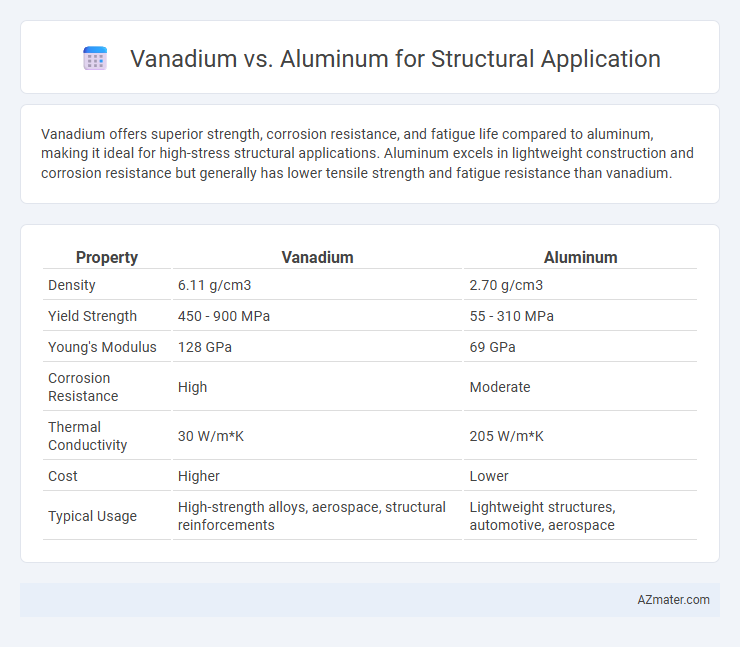Vanadium offers superior strength, corrosion resistance, and fatigue life compared to aluminum, making it ideal for high-stress structural applications. Aluminum excels in lightweight construction and corrosion resistance but generally has lower tensile strength and fatigue resistance than vanadium.
Table of Comparison
| Property | Vanadium | Aluminum |
|---|---|---|
| Density | 6.11 g/cm3 | 2.70 g/cm3 |
| Yield Strength | 450 - 900 MPa | 55 - 310 MPa |
| Young's Modulus | 128 GPa | 69 GPa |
| Corrosion Resistance | High | Moderate |
| Thermal Conductivity | 30 W/m*K | 205 W/m*K |
| Cost | Higher | Lower |
| Typical Usage | High-strength alloys, aerospace, structural reinforcements | Lightweight structures, automotive, aerospace |
Introduction to Vanadium and Aluminum in Structural Applications
Vanadium is a critical alloying element known for enhancing the strength, toughness, and corrosion resistance of steel structures, making it essential in high-performance structural applications such as bridges and skyscrapers. Aluminum offers a lightweight alternative with excellent corrosion resistance and a high strength-to-weight ratio, commonly used in aerospace, automotive, and building facades. Both metals are pivotal in engineering design, with vanadium alloys providing superior durability and aluminum enabling weight savings and energy efficiency in structural frameworks.
Chemical and Physical Properties Comparison
Vanadium exhibits superior strength-to-weight ratio and higher corrosion resistance compared to aluminum, making it ideal for high-stress structural applications. Its melting point of 1910degC significantly exceeds aluminum's 660degC, providing better thermal stability and mechanical performance under extreme conditions. Aluminum offers excellent corrosion resistance due to its oxide layer, but its lower density and inferior tensile strength limit its use in heavy-load frameworks where vanadium alloys excel.
Strength-to-Weight Ratio: Vanadium vs Aluminum
Vanadium alloys exhibit a significantly higher strength-to-weight ratio compared to aluminum, making them ideal for high-performance structural applications where weight savings are critical. Vanadium's tensile strength can exceed 1,000 MPa while maintaining a relatively low density around 6.0 g/cm3, whereas aluminum alloys typically have tensile strengths between 200-600 MPa with densities close to 2.7 g/cm3. This superior strength-to-weight efficiency allows vanadium-based materials to deliver enhanced load-bearing capacity without substantial weight increases, outperforming aluminum in aerospace and advanced engineering contexts.
Corrosion Resistance and Durability
Vanadium alloys exhibit superior corrosion resistance and durability compared to aluminum, particularly in harsh environments such as chemical processing and marine applications. While aluminum naturally forms a protective oxide layer to resist corrosion, vanadium alloys maintain structural integrity under higher temperatures and oxidative stress due to their stable oxide films. This makes vanadium alloys preferable for long-term structural applications requiring enhanced resistance to corrosion and mechanical wear.
Fatigue and Wear Performance
Vanadium alloys exhibit superior fatigue resistance compared to aluminum, making them ideal for high-stress structural applications requiring long-term durability. Vanadium's exceptional hardness and wear resistance outperform aluminum, reducing maintenance and extending component life in abrasive environments. While aluminum offers lightweight benefits, vanadium's enhanced fatigue strength and wear performance provide critical advantages in demanding structural uses.
Cost and Availability
Vanadium is significantly more expensive and less abundant compared to aluminum, making aluminum the preferred choice for cost-sensitive structural applications. Aluminum's widespread availability and lower extraction and processing costs contribute to its economic advantage in construction and automotive industries. Despite vanadium's superior strength and corrosion resistance, its high price limits its use to specialized applications requiring enhanced performance.
Machinability and Fabrication Processes
Vanadium alloys exhibit superior machinability compared to aluminum due to their higher strength and hardness, which require specialized cutting tools and slower feed rates to avoid tool wear. Aluminum offers excellent machinability with standard tools, enabling faster fabrication processes like milling, drilling, and welding without significant tool degradation. Fabrication of vanadium components demands controlled environments and precise heat treatments to maintain structural integrity, whereas aluminum's lightweight and ductile properties facilitate easier forming and joining methods in structural applications.
Environmental Impact and Sustainability
Vanadium alloys offer higher strength-to-weight ratios and improved fatigue resistance compared to aluminum, enabling longer-lasting structures with less frequent material replacement. The extraction of vanadium typically involves energy-intensive processes, but its enhanced durability can reduce overall environmental impact by lowering maintenance and resource consumption over the structure's lifespan. Aluminum, although widely recyclable and abundant, has a higher carbon footprint in primary production due to bauxite mining and smelting, posing sustainability challenges despite its recyclability advantage.
Case Studies: Industry-Specific Applications
Vanadium's high strength-to-weight ratio and excellent corrosion resistance have made it a preferred alloying element in aerospace and automotive industries, as demonstrated in case studies involving high-performance titanium-vanadium alloys used in aircraft frames and engine components. Aluminum, widely tested in construction and transportation sectors, offers superior machinability and cost-effectiveness, evidenced by successful applications in lightweight automotive body panels and building facades that demand durability and energy efficiency. Comparative analysis of case studies reveals vanadium-enhanced alloys excel in high-stress, fatigue-prone environments, while aluminum dominates in large-scale structural applications requiring ease of fabrication and economic viability.
Conclusion: Selecting the Right Material for Structural Needs
Vanadium offers superior strength-to-weight ratio and corrosion resistance compared to aluminum, making it ideal for high-stress structural applications requiring durability and longevity. Aluminum provides excellent lightweight properties and ease of fabrication, suitable for less demanding structures or where cost efficiency is prioritized. The choice depends on balancing performance requirements, environmental conditions, and budget constraints to optimize structural integrity and lifespan.

Infographic: Vanadium vs Aluminum for Structural Application
 azmater.com
azmater.com